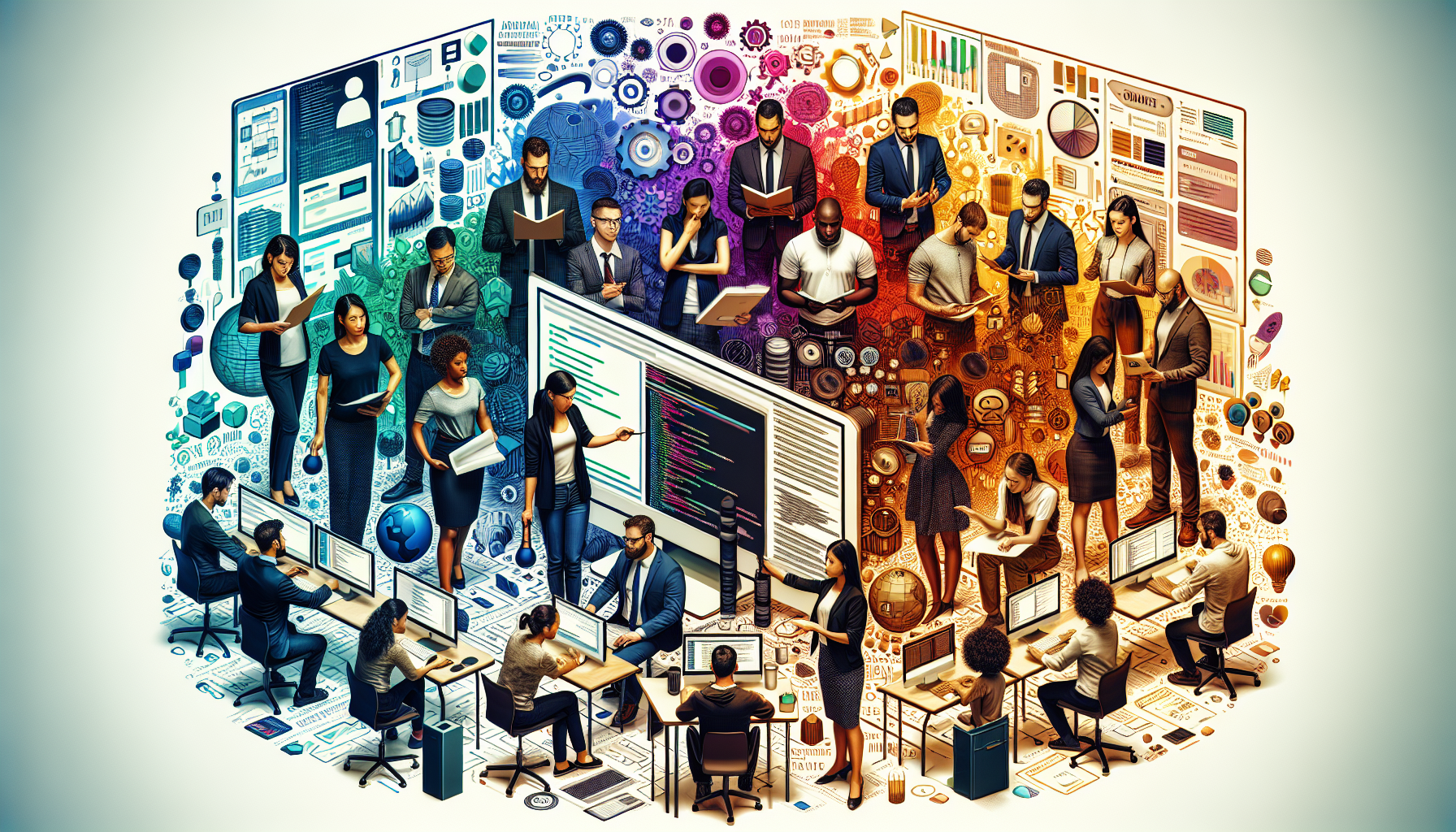On this page
The content discusses a panel discussion on the influence and potential of Artificial Intelligence (AI) in various fields. The speakers, who hail from Google, YouTube, and Waymo, delve into their experiences with AI in their respective domains. They highlight AI's role in personal productivity, project management, content generation, and document critique. They also discuss the importance of staying updated with technological advances, citing resources such as conversations with team members, Twitter, hackathons, and newsletters. The discussion concludes on the note of AI's significant influence on product design, stressing the need for Product Managers to acquire relevant skills for AI-driven product design.
How does it apply to you?
AI can be used to automate repetitive tasks, enhance personal productivity, and improve the understanding of complex information. For instance, AI can be used to summarize long documents, making them more concise and suitable for various forms of communication. It can also be used creatively for tasks such as project naming, and for adding interesting images to presentations. AI can also be used to critique a document, ensuring it is written in a format that is understandable to its intended audience. These applications of AI can be particularly useful in the field of software development, where clear communication and understanding of complex information are crucial.
Applied Learning to Developer Enablement
AI for Summarization and Creativity
AI can be used for summarizing lengthy software documentation, making it more concise and easier to comprehend. It can also be used for creative tasks such as generating project names and adding images to presentations, thereby enhancing the overall project delivery.
AI as a Co-pilot for Critique and Understanding
AI can serve as a critique tool in software development, ensuring that the code and documentation are understandable to the intended audience. It can help in making the software more user-friendly and accessible.
AI's Influence on Product Design
Understanding the influence of AI on product design can guide software developers in incorporating AI into existing products and designing new 'AI-first' products.
Essential Skills for AI-Driven Product Design
Software developers working on AI-driven product design need to acquire relevant skills and knowledge. This includes understanding the principles of AI, its capabilities, and its limitations.
Developer Checklist Refined
AI in Content Creation and Analysis
Staying Updated on Technological Advances
AI in Product Development
AI in Team Management
AI in Product Pricing
Summary
Introduction and Panelist Backgrounds
The session begins with introductions from the host and panelists. The host, Goin Koser, is a product manager at Google who focuses on AI applications in the Enterprise domain. The first panelist, Stacy Cronin, works at YouTube, part of Google, and is part of the Trust and Safety Team. She discusses the potential uses and challenges of AI in the context of YouTube, from potential abuse to creative aspects and tooling. The second panelist, John Mark, is a product director at Waymo, an Alphabet company. He has been working in the logistics and ride share delivery space for about 10 years and discusses the evolution of AI in these fields, from Uber to Waymo's self-driving cars.
AI's Influence on Personal Productivity
The panelists discuss how AI has influenced their lives and improved their personal productivity. John Mark shares his experiences using AI to understand user feedback at Uber, which was initially manually triaged by large numbers of humans. AI was used to classify and find patterns in user feedback, uncovering nuances that humans didn't pick up on. He also mentions experimenting with AI for document creation and content generation, as well as its use in the development of autonomous vehicles at Waymo.
Potential of ERDs and PM Productivity
The speaker discusses the potential of Entity Relationship Diagrams (ERDs) as a tool for project management. ERDs offer a consistent structure for problem-solving, outlining opportunities, solutions and constraints. However, the speaker notes that there's a lot of repetitive work involved in their creation, which can be time-consuming. Therefore, there is potential in making project managers more productive by developing tools that can craft documents more quickly, summarise them and help to distill complex information into a more understandable form.
AI for Summarization and Creativity
The speaker discusses the usefulness of AI for summarizing long documents, making them more concise and suitable for various forms of communication. AI can also be used creatively for tasks such as project naming, and for adding interesting images to presentations. These applications of AI can make documents more engaging and can help to elicit support for a plan or project.
AI as a Co-pilot for Critique and Understanding
AI can be used to critique a document, ensuring it is written in a format that is understandable to its intended audience. This can be particularly useful when the audience may not understand all the complexities or nuances of a topic. The speaker suggests that AI can act as a co-pilot, unlocking the potential of a document and making it more accessible.
Staying Up-to-Date with Technological Advances
Given the fast-paced nature of technological advances, the speaker shares that their favorite resource for staying up-to-date is through conversations with team members and engineers. This method provides insights into new developments and trends. The speaker also mentions reading articles for a bigger picture of what's happening in the industry, including major events such as changes in leadership.
Importance of Twitter for Information Gathering
Twitter is highlighted as a valuable resource for staying updated on the latest advancements and trends. By following a diverse group of individuals, including researchers, startup founders, and engineers, one can gain insights into various fields and emerging technologies. Twitter serves as a platform for global knowledge sharing, where one can learn about new breakthroughs and innovative ideas.
Value of Hackathons and Advising
Participating in hackathons, particularly in tech-hub cities like San Francisco, and advising or investing in startups can also be enlightening. These activities provide opportunities to engage with engineers and entrepreneurs who are working on the cutting edge, enabling one to absorb new ideas and understand current trends. Such direct interaction can be a rich source of knowledge and inspiration.
Role of Newsletters in Staying Informed
Subscribing to newsletters, especially those that provide a 'Too Long; Didn't Read' (TLDR) summary of recent events, is another recommended way to stay abreast of relevant developments. These newsletters can provide a comprehensive overview of the previous day's news, ensuring that important updates related to one's work are not missed.
AI's Influence on Product Design
Artificial Intelligence (AI) is expected to significantly influence product design, with two parallel trends emerging. The first involves incorporating AI into existing products, while the second entails designing new products based on 'AI-first' principles. Both approaches have been observed in the strategies of major tech companies and startups alike. The discussion further highlights the need for product managers (PMs) to acquire relevant skills and knowledge to effectively work on AI-related projects.
Essential Skills for AI-Driven Product Design
Skills needed to stay at the forefront of AI-driven product design include both tactical and strategic aspects. It's essential to consider both short-term applications of AI, such as document summarization, and long-term implications, particularly how AI might transform user interfaces. The potential for AI to disrupt traditional product interfaces or enable competitors to more efficiently engage customers is a crucial consideration.
Importance of Customer Needs and Product-Market Fit
Understanding customer needs and achieving product-market fit remain core skills for managing AI-driven products. PMs should continuously question whether a new AI capability genuinely solves a customer problem or delivers a business benefit. Cultivating a culture of questioning and experimentation within their teams is essential. While not all attempts to incorporate AI into products may succeed, a willingness to experiment, learn, and adapt based on market responses is crucial.
Iterative Cycle of Product Development in AI
The discussion highlights the iterative nature of product development in the field of AI. Unlike traditional software engineering where you have a set path of requirements, test cases, and engineering plans, AI projects involve a more exploratory approach. This includes starting with an idea, quickly prototyping it, and then going through cycles of quality improvement. The speaker suggests that this approach will likely be the norm until AI technology becomes more established and mainstream.
Driving Change Within Engineering
The speaker addresses a question about driving change within engineering teams due to the impact of AI tools. They recommend adopting a more iterative approach to building and measuring models. They emphasize the importance of application engineers who think about the products built on top of AI models. The speaker also suggests that other teams, such as operations support, may be more impacted by the automation brought about by AI, leading to changes in job roles and required skills.
Impact of AI Tools on Engineering Teams' Structure and Skills
The discussion moves to the impact of AI tools on the structure and skills of engineering teams. The speaker notes that while these tools may not eliminate the need for good engineers, they will require engineers to build and iterate on models more effectively. They also suggest that engineers will need to think more about system design and architecture, rather than focusing on lower-level tasks that can now be automated.
Trends in Engineering and the Role of AI
The speaker discusses the trend of engineers moving 'up the stack' due to AI and automation. They note that many basic tasks that engineers used to perform are now being automated, freeing up engineers to focus more on system design and architecture. The speaker suggests that this move up the stack can help engineering teams get more done, as they can focus more on high-level tasks that humans are better at.
Changing Dynamics of Cross Functional Teams with AI
The conversation highlights the impact of AI on the functioning of different teams within an organization, not just engineering. It emphasizes how a Project Manager (PM) collaborates with various teams such as design, legal, marketing, and business development, etc. The discussion further extends to how non-engineering team members, like those in marketing or business development, need to understand the implications of AI on their work and the level of understanding they need to stay relevant.
Demystifying AI for Non-Technical Teams
The speaker suggests that the key to helping non-technical team members understand AI is to demystify it. This can be achieved by relating AI technologies to familiar experiences, like autocomplete in search engines. By highlighting how AI technologies can make their jobs easier and enhance their creativity, the speaker believes non-technical team members can better appreciate and utilize AI. It's also important for them to understand AI from the consumer side, to better envision the kind of AI-enabled products or services they can bring to the market.
AI's Role in Enhancing Job Roles and Increasing Leverage
AI is seen as a tool that can increase leverage across various roles, including marketing and design. For instance, AI can help generate ad copy or expedite the design process by providing building blocks. This not only speeds up these processes but also opens up new possibilities for creativity and efficiency.
Impact of AI on Product Pricing and Revenue Models
The speaker explores the potential impact of AI on product pricing and revenue models. As AI reduces operational costs, including the costs associated with product development (like the number of engineers required), the cost of building a product can go down. However, it's not necessarily implied that the end products will become cheaper for consumers. The speaker suggests that reduced costs might lead to higher profits or increased product reach, rather than lower consumer prices. Also, there could be increased costs in other areas, like computation power. AI could also increase the value of certain tasks while reducing the cost for others.
Potential for Premium Models in Mental Health Apps
A discussion on the potential for premium models in mental health services, particularly with the use of chatbots. The speaker suggests that as chatbots improve, they can attract more users into a free or low-cost product, which could in turn generate demand for higher-priced, specialized support services. This approach extends the funnel by providing an affordable entry point, while simultaneously driving value towards higher-touch, more experienced products or services.
Variation in Pricing Models Across Different Verticals
The speakers agree that cost reduction through AI will vary significantly across different industries. For SaaS products and certain professional services, AI can potentially cut a significant portion of costs. However, in businesses with high asset costs, such as ride-sharing or autonomous vehicles, AI might only marginally reduce costs associated with product development or support, as the substantial costs related to physical assets and infrastructure remain.
Closing Remarks
The speakers express their enjoyment of the discussion and the opportunity to delve into these topics. They also express the sentiment that it's an exciting time to be alive, given the rapid advancements in technology and AI.
FAQs
What are the panelists' backgrounds in the discussion on 'Crafting a Culture of AI in Your Team'? The host, Goin Koser, is a product manager at Google who focuses on AI applications in the Enterprise domain. The first panelist, Stacy Cronin, works at YouTube, part of Google, and is part of the Trust and Safety Team. The second panelist, John Mark, is a product director at Waymo, an Alphabet company.
How has AI influenced personal productivity according to the panelists? John Mark shares his experiences using AI to understand user feedback at Uber, which was initially manually triaged by large numbers of humans. AI was used to classify and find patterns in user feedback, uncovering nuances that humans didn't pick up on. He also mentions experimenting with AI for document creation and content generation, as well as its use in the development of autonomous vehicles at Waymo.
What is the potential of Entity Relationship Diagrams (ERDs) in project management? ERDs offer a consistent structure for problem-solving, outlining opportunities, solutions and constraints. However, there's a lot of repetitive work involved in their creation, which can be time-consuming. Therefore, there is potential in making project managers more productive by developing tools that can craft documents more quickly, summarise them and help to distill complex information into a more understandable form.
How can AI be used for summarization and creativity? AI can be used to summarize long documents, making them more concise and suitable for various forms of communication. AI can also be used creatively for tasks such as project naming, and for adding interesting images to presentations.
How can AI be used as a co-pilot for critique and understanding? AI can be used to critique a document, ensuring it is written in a format that is understandable to its intended audience. This can be particularly useful when the audience may not understand all the complexities or nuances of a topic.
What are some ways to stay up-to-date with technological advances? The speaker shares that their favorite resource for staying up-to-date is through conversations with team members and engineers. This method provides insights into new developments and trends. The speaker also mentions reading articles for a bigger picture of what's happening in the industry, including major events such as changes in leadership.
Why is Twitter valuable for information gathering? Twitter is highlighted as a valuable resource for staying updated on the latest advancements and trends. By following a diverse group of individuals, including researchers, startup founders, and engineers, one can gain insights into various fields and emerging technologies.
What is the value of hackathons and advising in staying informed about new technologies? Participating in hackathons, particularly in tech-hub cities like San Francisco, and advising or investing in startups can also be enlightening. These activities provide opportunities to engage with engineers and entrepreneurs who are working on the cutting edge, enabling one to absorb new ideas and understand current trends.
What is the role of newsletters in staying informed about new technologies? Subscribing to newsletters, especially those that provide a 'Too Long; Didn't Read' (TLDR) summary of recent events, is another recommended way to stay abreast of relevant developments. These newsletters can provide a comprehensive overview of the previous day's news, ensuring that important updates related to one's work are not missed.
How is AI expected to influence product design? Artificial Intelligence (AI) is expected to significantly influence product design, with two parallel trends emerging. The first involves incorporating AI into existing products, while the second entails designing new products based on 'AI-first' principles. Both approaches have been observed in the strategies of major tech companies and startups alike.
What skills are needed to stay at the forefront of AI-driven product design? Skills needed include both tactical and strategic aspects. This involves considering both short-term applications of AI, such as document summarization, and long-term implications, particularly how AI might transform user interfaces.
What is the importance of customer needs and product-market fit in managing AI-driven products? Understanding customer needs and achieving product-market fit remain core skills for managing AI-driven products. PMs should continuously question whether a new AI capability genuinely solves a customer problem or delivers a business benefit.
What is the iterative cycle of product development in AI? AI projects involve a more exploratory approach including starting with an idea, quickly prototyping it, and then going through cycles of quality improvement until AI technology becomes more established and mainstream.
How can AI impact the structure and skills of engineering teams? AI tools may require engineers to build and iterate on models more effectively and think more about system design and architecture, rather than focusing on lower-level tasks that can now be automated.
How does AI affect the dynamics of cross functional teams within an organization? AI impacts the functioning of different teams within an organization, not just engineering. Non-engineering team members, like those in marketing or business development, need to understand the implications of AI on their work and the level of understanding they need to stay relevant.
How can non-technical team members understand AI? Non-technical team members can understand AI by relating AI technologies to familiar experiences, like autocomplete in search engines, and by understanding AI from the consumer side.
How can AI enhance job roles and increase leverage? AI can increase leverage across various roles, including marketing and design. For instance, AI can help generate ad copy or expedite the design process by providing building blocks, speeding up these processes and opening up new possibilities for creativity and efficiency.
What is the potential impact of AI on product pricing and revenue models? As AI reduces operational costs, including the costs associated with product development, the cost of building a product can go down. However, it's not necessarily implied that the end products will become cheaper for consumers. Reduced costs might lead to higher profits or increased product reach, rather than lower consumer prices. Also, there could be increased costs in other areas, like computation power.
What is the potential for premium models in mental health apps? As chatbots improve, they can attract more users into a free or low-cost product, which could in turn generate demand for higher-priced, specialized support services. This approach extends the funnel by providing an affordable entry point, while simultaneously driving value towards higher-touch, more experienced products or services.
How does the variation in pricing models occur across different verticals? Cost reduction through AI will vary significantly across different industries. For SaaS products and certain professional services, AI can potentially cut a significant portion of costs. However, in businesses with high asset costs, such as ride-sharing or autonomous vehicles, AI might only marginally reduce costs associated with product development or support, as the substantial costs related to physical assets and infrastructure remain.
What was the sentiment expressed in the closing remarks? The speakers expressed their enjoyment of the discussion and the opportunity to delve into these topics. They also expressed the sentiment that it's an exciting time to be alive, given the rapid advancements in technology and AI.
Glossary
AI-driven product design: A process that involves the use of artificial intelligence (AI) to create, test, and refine a product design. It includes both short-term applications, such as document summarization, and long-term implications, particularly how AI might transform user interfaces.
Customer Needs and Product-Market Fit: Understanding what the customer requires and ensuring that the product satisfies those needs. This remains a core skill for managing AI-driven products.
Iterative Cycle of Product Development in AI: Unlike traditional software engineering, AI projects involve a more exploratory approach, starting with an idea, quickly prototyping it, and then going through cycles of quality improvement.
Driving Change Within Engineering: The process of adapting engineering teams to the impact of AI tools, which involves adopting a more iterative approach to building and measuring models.
Impact of AI Tools on Engineering Teams' Structure and Skills: AI tools require engineers to build and iterate on models more effectively, focusing more on system design and architecture, rather than lower-level tasks that can now be automated.
Trends in Engineering and the Role of AI: AI and automation are leading to engineers moving 'up the stack', focusing more on system design and architecture as many basic tasks are now being automated.
Changing Dynamics of Cross Functional Teams with AI: AI influences the functioning of different teams within an organization, requiring non-engineering team members to understand the implications of AI on their work.
Demystifying AI for Non-Technical Teams: The process of making AI technologies understandable and relatable to non-technical team members, helping them appreciate and utilize AI.
AI's Role in Enhancing Job Roles and Increasing Leverage: AI can increase leverage across various roles, including marketing and design, by speeding up processes and opening up new possibilities for creativity and efficiency.
Impact of AI on Product Pricing and Revenue Models: AI can potentially reduce operational costs, including those associated with product development, which might lead to higher profits or increased product reach, rather than lower consumer prices.
Premium Models in Mental Health Apps: The potential for using premium models in mental health services, particularly with chatbots. As chatbots improve, they can attract more users into a free or low-cost product, which could generate demand for higher-priced, specialized support services. This approach extends the funnel by providing an affordable entry point, while driving value towards higher-touch, more experienced products or services.
SaaS: Software as a Service, a software licensing and delivery model in which software is licensed on a subscription basis and is centrally hosted.
Variation in Pricing Models Across Different Verticals: The idea that cost reduction through AI will vary significantly across different industries. For SaaS products and certain professional services, AI can potentially cut a significant portion of costs. However, in businesses with high asset costs, such as ride-sharing or autonomous vehicles, AI might only marginally reduce costs associated with product development or support, as the substantial costs related to physical assets and infrastructure remain.




